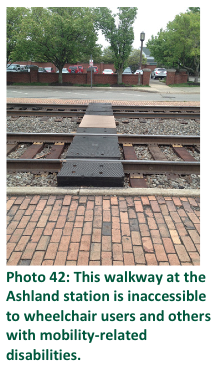Report: 95% Of Amtrak Stations Have “Major Barriers” For Disabled
 More than two decades after the passage of the Americans with Disabilities Act, a new survey of Amtrak stations around the country claims that the overwhelming majority of them still fall far short of being accessible for passengers with special needs and that some are still completely inaccessible to consumers who use wheelchairs and other mobility devices.
More than two decades after the passage of the Americans with Disabilities Act, a new survey of Amtrak stations around the country claims that the overwhelming majority of them still fall far short of being accessible for passengers with special needs and that some are still completely inaccessible to consumers who use wheelchairs and other mobility devices.
The report [PDF] from the National Disability Rights Network surveyed the conditions at 94 Amtrak stations in 25 states, and according to the NDRN, 89 stations (95%) “have major barriers preventing people with disabilities from using the nation’s rail system.”
Only five of stations in the survey — Trenton, NJ; Sanford, FL; Durham, NC; and Lynchburg and Culpepper in Virginia — presented no architectural accessibility impediments. But even then, reports NDRN, the Durham and Culpepper stations lacked display equipment for hearing-impaired consumers.
Examples of inaccessible stations could be found in Tuscaloosa, AL, Malta, MT, Longview, TX, St. Albans, VT, and Ashland, VA. The NDRN says each of these stations has steps at its entrance but no ramp, and that the bathrooms in all of these Amtrak stops are “completely inaccessible, with no grab bars or other accessible features.”
Restrooms were a common problem in the survey, with nearly half of stations visited found to be lacking in accessibility features.
 If you’re in a wheelchair or otherwise unable to climb up and down steps, good luck switching platforms in Marshall, TX, Newark, DE, and Harpers Ferry, WV, all of which require going upstairs to a bridge or downstairs to a tunnel in order to reach the other platform.
If you’re in a wheelchair or otherwise unable to climb up and down steps, good luck switching platforms in Marshall, TX, Newark, DE, and Harpers Ferry, WV, all of which require going upstairs to a bridge or downstairs to a tunnel in order to reach the other platform.
Other frequently found barriers to accessibility were badly deteriorated sidewalks and walkways, door hardware that is difficult to operate, inaccessible ticket counters, and poor platform conditions.
“Our reviews show that Amtrak’s negligence goes beyond simply ignoring the Americans with Disabilities Act (ADA), but demonstrates a deliberate disregard for passengers with disabilities,” said NDRN’s executive director Curt Decker. “If you are a person with a disability who wishes to travel on Amtrak, the message is pretty clear: you are not welcome here.”
 We reached out to Amtrak for comment on this report and in return it provided was a link to a press release from July in which it pats itself on the back for making ADA-related improvements during the last four years.
We reached out to Amtrak for comment on this report and in return it provided was a link to a press release from July in which it pats itself on the back for making ADA-related improvements during the last four years.
Amtrak did recently write to Congress about its work and goals in improving accessibility — including providing accessible paths between platforms and bringing station restrooms and counters into compliance — but only at the stations actually owned by Amtrak.
This is where we point out that Amtrak only owns about 14% of the 500 stations it uses, while the rest are owned by a mix of other railroads, state transportation agencies, and private developers.
Want more consumer news? Visit our parent organization, Consumer Reports, for the latest on scams, recalls, and other consumer issues.

